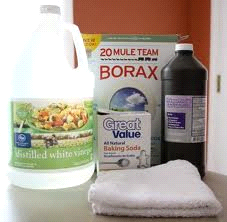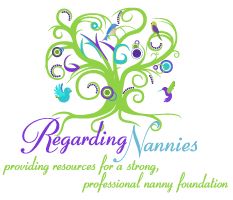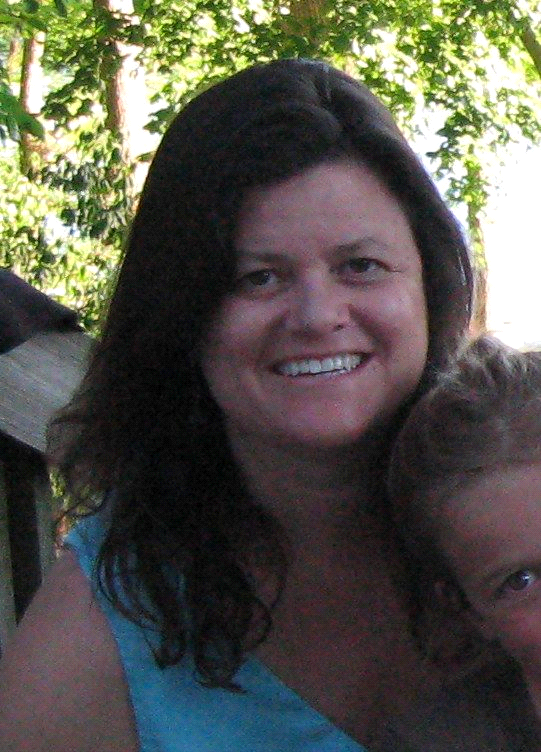Homemade Natural Cleaners: Great for the Environment, Your Health, and Your Budget
by Cheryl Hunter

In the last few years, with the global realization that our environment and climate are changing, I have been changing my lifestyle in order to do not only what is best for the environment, but also best for the health of my household, by using natural, non-toxic products in my home. One of the most interesting and actually fun projects I took on was to make my own household cleaning products.
Creating your own cleaners is much cheaper than buying them, and I have discovered that, with the right recipes, homemade cleaning products work as well as the traditional, store-bought, toxic chemical-laden cleaners, and some of them actually do a BETTER job, like my “Recipe for a Very Clean Toilet” below. Another bonus is that if your children/charges are old enough to be helping with chores, they can use these cleaners with your supervision and with no worry that they will be exposed to toxic fumes or substances. Cleaning their toilet with the “Toilet Bomb” recipe below was especially fun for my 9- and 7-year old charges, and made them more responsible for their own messes. Making the cleaners can also be a fun activity, and is an opportunity to teach them science, math, measuring, mixing and pouring.
I started my transition to all-natural, homemade cleaners by using Pinterest.com to gather the formulas and instructions. Personally, I love Pinterest as an easy way to visually organize information from the Web (see my Pinterest board on household cleaners with over 80 different recipes here: http://pinterest.com/moozyblue/diy-home-cleaning/ ). If you are hesitant to use Pinterest, just google “homemade cleaners” and you will find a ton of information. With a good recipe, you can make virtually any cleaner, whether it be dishwashing or laundry soap, tub & tile cleaners, cleansing powder (like Comet), stain removers (like OxiClean), floor cleaner, glass cleaner, even wood polish — you name it.
After gathering recipes, I shopped for the essential ingredients. You only need 9 basic staples to make almost any cleaner: baking soda, distilled white vinegar, hydrogen peroxide, rubbing alcohol, Borax, salt, a liquid soap (like Dr. Bronner’s castile soaps), unsweetened Kool-Aid lemonade (or Tang), and essential oils–orange, lavender, and/or tea tree oil for clean fragrance (tea tree oil has antimicrobial properties as well–i.e., it kills germs). You will find you use the first two–baking soda and vinegar–in most of your cleaning concoctions, so I recommend buying the largest sizes possible. Costco sells a 13.5 lb. bag of baking soda, and you can get a 1-gallon bottle of vinegar in most grocery stores or drugstores. Also, I rinsed out and saved the spray bottles from old cleaners and parmesan cheese containers so I could use them for the new spray cleaners and cleansing powders, respectively.
To ease my changeover to making my own, I decided to continue to use whatever commercial cleaners I had left, and as I ran out of each kind, I would make a new one using the recipes I found and with my 9 basic staples. I knew that transitioning gradually would help prevent me from getting overwhelmed, which I knew was my biggest obstacle to making the change.
Although I found the entire process enjoyable, the real fun started when I began making the cleaners. I found it was relatively simple, and I had a good time tweaking the recipes and figuring out what worked best (some of these “final version” recipes are written below). The very first homemade cleaners I made were for the toilet. I used to clean the toilet with Pine Sol simply because my mother did (40 years ago!), and I associated the smell to mean “clean.” I would follow that up with CLR– a very toxic cleaner– that would remove the hard water stains (but only along with a good scrubbing and/or letting it sit in the toilet for awhile). Now, after experimenting, here is my favorite way (and it works better than my old way) to clean the toilet:
Recipe for a Very Clean Toilet (aka, “Toilet Bomb with a Lemonade Chaser”): 1) Get an empty jar and a spoon and put 1/3 cup baking soda in the jar, 2) Add a few drops of Tea Tree Oil, then 3) Over the toilet bowl (with seat up), pour about a 1/2 cup white vinegar into the jar and stir immediately with spoon–this is the part where it becomes a fizzing “bomb”; it doesn’t actually explode of course, but it does fizz up like a shaken soda and may fizz over the top of your jar–so be ready to dump the whole concoction in the toilet, then use a toilet brush around the bowl and under the rim. After scrubbing for a minute or two, flush the toilet. 4) Next, pour a packet of unsweeted Kool-Aid, lemonade flavor, under the rim and around the inside of the bowl, anywhere you see hard water stains. Having just flushed the toilet, the Kool-Aid powder will stick to those spots where the hard water is. Let it sit for at least 10 minutes. Then take your toilet brush and scrub all around again to remove the hard water spots. If you need to, use a pumice stone to help remove tough hard water stains — but, once you start using Kool-Aid regularly (about once every other week), you should only have to use the pumice the very first time you do this. The Kool-Aid step will also be fun for the kids, and it has a nice scent. Now let the “Lemonade” sit for another 10 minutes or more (letting it sit allows it to eat away at the hard water stains, so don’t eliminate this step). Give the toilet a final flush, then clean the seat & lid with your natural all-purpose cleaner. Since I have been cleaning my toilets this way, I have noticed that they actually stay cleaner for longer…. I have no idea why, but I love it!
More Recipes
All Purpose Cleaner: This works great as a glass cleaner, floor cleaner, or on stainless steel, tile or other hard surfaces (do not use on granite or on hardwood floors, but wood laminate is fine): 1 cup Water, 3/4 cup Distilled White Vinegar, 1 cup Rubbing Alcohol, 3 drops Liquid Soap (Dr. Bronner’s Castile is good, or just use your standard dishwashing liquid soap), 15 drops Essential Oil (to help mask vinegar smell)–I use either citrus or lavender oil. Mix everything together and put in a spray bottle. Shake before using.
Carpet Freshener: Take 2 cups Baking Soda and put in bowl. Drop several drops of Orange Essential Oil and stir to mix throughout. Pour into an empty, clean parmesan cheese container. Sprinkle over carpet, let sit 20 minutes, and vacuum up.
Cleansing Powder (like Comet, but not as abrasive); great for sinks, tubs & showers: 1.5 parts Baking Soda, 1 part Salt, 1 part Borax. Add Kool-Aid Unsweetened Lemonade powder – I add about 2 packets when salt or borax measurement is 1/2 cup. Place in a clean, empty parmesan cheese container. Wet sink or surface to be cleaned. Sprinkle over surface. Wait about 5 minutes, then scrub with a wet sponge. Wait 15 more minutes (especially to allow the wet Kool-Aid to work on the hard water scum), scrub and rinse.
Dishwasher Detergent and Rinse Aid: Mix equal parts Baking Soda and Borax and put into a jar with lid. Spoon the mixture directly into your dishwasher detergent receptacle as you would regular detergent. Pour White Vinegar (don’t dilute) into the Rinse Aid receptacle–it works.
Greatest Grout Cleaner: Pour thin line of Baking Soda over grout, then pour or drip Hydrogen Peroxide directly onto it to make a paste. Scrub a little with an old toothbrush and let sit for at least 30 minutes or until you see white. Wipe off with wet cloth or sponge, then remove any excess with your all-purpose cleaner.
Laundry Soap: I am still working on this one. The old recipes called for a lot of work, shaving soap and cooking baking soda. I just recently found a much simplified recipe that I haven’t tried yet — just 3 ingredients + water, and shake. Here’s a link if you’d like to try it: http://amy-newnostalgia.blogspot.com/2013/02/no-grate-no-cook-liquid-laundry.html
Stain Remover and Whitener (similar to OxiClean; works on clothing, carpet, and more): 1/2 cup Baking Soda, 1/2 cup Hydrogen Peroxide, and 1 cup Water. Mix and put in spray bottle.
If you were anything like me, you might feel a little attached to your old-school brand-name cleansers, but it is important to know that virtually all of those traditional cleansers contain toxic ingredients that are both harmful to the environment and to your health. Here is a little more information on just two ingredients that are commonly in commercial cleaners:
(The Lowdown on) Chlorine Bleach: Although bleach is a very effective antimicrobial, there are other products that are considered non-toxic and that kill germs just as effectively (rubbing alcohol and tea tree oil, for example). The chlorine in bleach is very bad for the environment, due to the toxic soup of chemicals that are released both through its manufacture and during use. [For me personally, I was hesitant to let go of bleach because it really is the only product that made my whites very white. But after learning just how harmful it is, and finding I could make a whitening cleaner that is at least 80% as whitening as chlorine bleach (equal parts of baking soda and hydrogen peroxide and water), I figure that not having my socks super-white is a small price to pay to make a big difference in the environment, not to mention my home environment.]
A note about “Fragrance”: The word “Fragrance” listed as an ingredient in any commercial product should basically alert you to the fact that it is carcinogenic–i.e., hormone disrupting and cancer-causing. Only use products scented with essential oils.
If you’d like to treat the environment better, take care of your health, and save several pennies in the process, I encourage you to start making your own cleaners using safe, bio-friendly ingredients.
Resources & Information
Article on Toxic Household Cleaners: http://www.motherjones.com/blue-marble/2011/11/toxins-household-cleaners-tide-clorox-glade-pinesol-febreze-simplegreen
Books:
Mrs. Meyer’s Clean Home, 2009, by Thelma A. Meyer
The Organic Suburbanite, 2001, by Warren Schultz
About the Author:
Cheryl Hunter lives and works as a nanny in the Bay Area. In 1996, after a 12-year career in Business, she realized one day that she could no longer tolerate working in a field that her heart wasn’t in. Two months later, after some serious soul-searching and career counseling, she got her first nanny job with newborn twins. 16 years later she is still loving being a nanny and is happy to make a good living doing what she loves most. Her other interests are reading, writing, laughing, singing, anything natural, psychology, healthy cooking (for babies, children & adults), feeding the homeless, and improv.


Why aren’t we installing more sooar panels globally, ths is becoming the energy source for tthe future of oour planet?
The vast benefits oof installing green energy has been proven many times.
Thee financial savigs can be enormous for enterprise operations and families alike.
I am always amazed how many members off the public still need to be persuaded
of the cost benefits that can be made by installiung
solar panels.